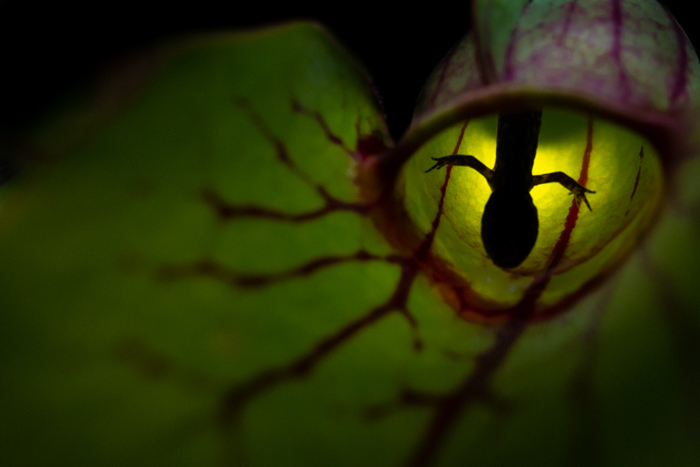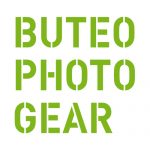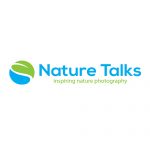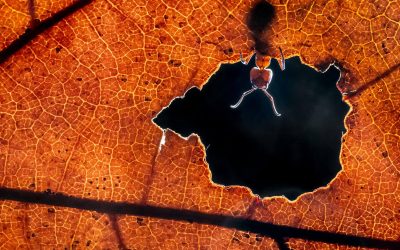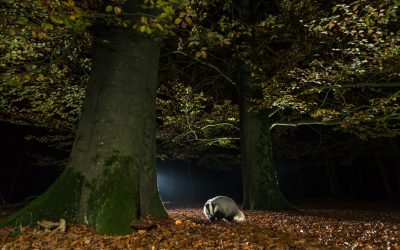How does a young biologist turned storyteller put her photographic and narrative skills to use to help us understand and protect our shared planet?
To get an answer to that question, I talked to the Canadian nature photographer Samantha Stephens, a biologist turned storyteller for science and conservation. She is a National Geographic explorer, an Ambassador for ‘Girls Who Click‘ and she contributes to initiatives like The Canid Project.
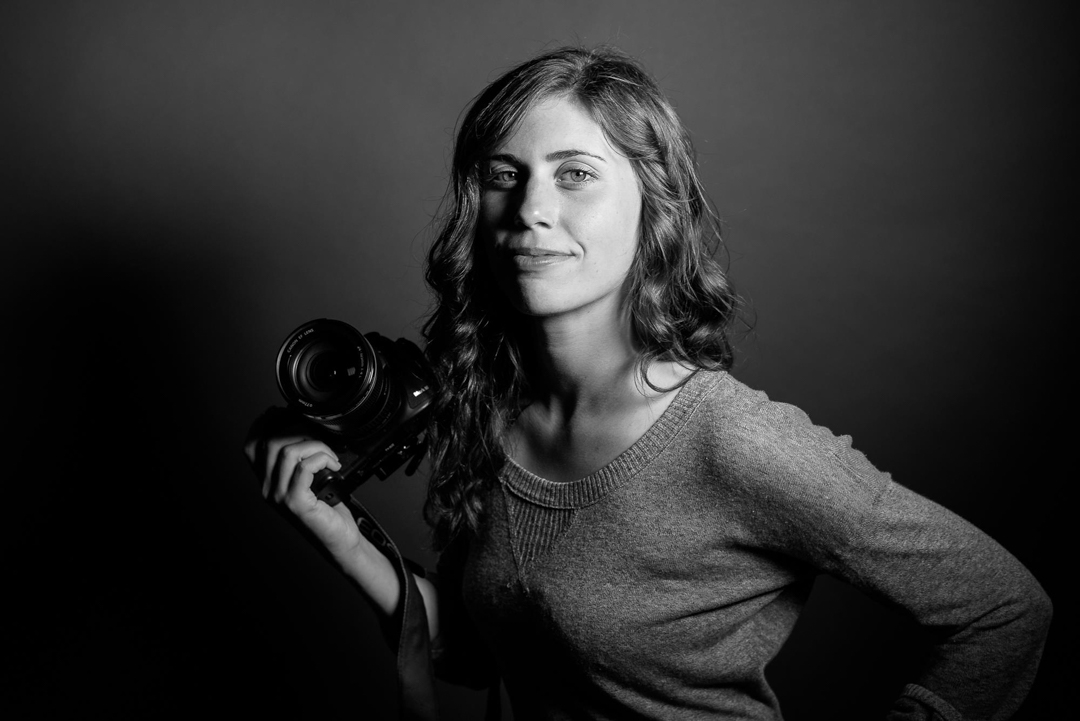
At the NPOTY contest 2020, she was the winner of the category ‘Other Animals’. Right now, she is based at the Algonquin Wildlife Research Station, a Canadian not-for-profit organization supporting wildlife research, education, and conservation. Time to get to know this talented photographer a bit better.

Spotted Salamanders are part of a long-term monitoring study at the Algonquin Wildlife Research Station, Samantha Stephens
Samantha Stephens has been interested in the natural world for as long as she can remember. She grew up in Ottawa, an urban area where nature was not at her doorstep. Her interest was initiated by others, like for instance National Geographic, telling stories about wildlife and the wonders of nature. Back at school the science lessons brought her the first hands-on experiences with wildlife and the natural world and fired up her passion. Science became her favorite class and when she was ready to go to college, studying biology was so obvious it wasn’t even a choice anymore… it was meant to be. In addition to being a trained biologist, she graduated from the Environmental Visual Communication program. Her purpose is to use her photography paired with written storytelling to communicate scientific research, especially research that is relevant to conservation issues. This way she hopes to contribute to our appreciation for the natural world. And for the work needed to understand how our natural world works and how we can protect it.

An adult Spotted Salamander compared to a juvenile, Samantha Stephens
Inspiration
“I remember the documentary film ‘Chasing Ice‘ (James Balog, 2012) was a huge source of inspiration for me to switch my career path from scientific research to science communication using photography. In this film, photographer James Balog showed with time-lapse photography the extent to which glaciers are receding. With this film he made us visualize the effects of climate change. I was so impressed by how this photography turned a scientific fact into a tangible and compelling story. Also, studying the work of photographers like Cristina Mittermeier, founder and Senior Fellow of the International League of Conservation Photographers (iLCP), and the other members of the iLCP, inspired me a lot.

Hayden illuminates a Northern Pitcher Plant, looking for juvenile Spotted Salamanders that have been trapped in the plant’s bell-shaped leaves, Samantha Stephens
The power of storytelling through visual content was very apparent to me and made me realize that I wanted to do that type of work. There are so many science and conservation stories that need to be shared. And I think photography is an effective tool to tell those stories in a way that has impact.
For the Canid Project and my National Geographic Early Career Storytelling Grant, I am currently working on the story of the Eastern Wolf (also called the Algonquin Wolf), a species that is at risk after decades of misunderstanding, persecution, and habitat loss. For this story, I am working with scientists as well as First Nations communities in Ontario.

Masters student Amanda Semenuk studies the recently discovered interection between juvenile Spotted Salamanders and Northern Pitcher Plant, Samantha Stephens
Bridging the gap
“During my studies in biology, I found that academia wasn’t structured in a way that made it easy for scientists to communicate their research to the general public — often there just isn’t enough time to focus on that, and some communication skills, like photography, can take a lot of time investment and additional skill development. This contributes to the gap between scientists and non-scientists, and I think it is one contributing factor to mistrust of knowledge that is created through the scientific process. I felt compelled to do work that tries to address this problem, bringing science to the public in a way that creates interest in science and an understanding of how the scientific process works.
Most of my projects start with a large amount of research and reading, and then joining scientists in the field, learning about their work by observing it. When I am more familiar with the ‘why, what, how’ of the study and its subject and have seen what the work looks like on the ground, then I start to brainstorm creative ways to tell the story of their project. By showing something new, something surprising, or something common in an unexpected way, I hope to grab the public’s interest. I try to add elements of mystery, or the unexpected, to my images to make people stop and say, ‘what is going on here?!’ I want people to be curious about what is happening in the photos and then want to delve deeper into the story. At the same time, I am showing the scientific process by presenting a ‘behind the scenes’ of this work, showing the public how scientific results are generated. By showing how the scientific process works, I hope to make people value and understand science and its outcomes more.”

In late summer, juvenile Spotted Salamanders leave their aquatic natal sites and seek over-wintering sites below the forest floor. It is on this journey that they may have to traverse a bog mat, where Northern Pitcher Plants lie in wait, Samatha Stephens
Communities
“The field of nature, science, and conservation photography are male-dominated. But there are many recent initiatives to get more women involved, helping them to break into this field and be successful.
One example is Her Wild Vision Initiative (HWVI), founded by Morgan Heim and Jaymi Heimbuch. HWVI is a directory of women who are active in the field of conservation photography and filmmaking, thus making it easy for potential clients and editors to contact and hire these (female) photographers. The database can be filtered by a number of parameters such as location, subject expertise, specific skills, and certifications, so clients can quickly find someone suitable for the story they need to tell. The hope is that this encourages clients and editors to diversify the photographers that they work with.

Antler Fly Research. Tracey Yu uses tinfoil to measure the surface area of the damaged parts of a shed moose antler, Samantha Stephens
Another example is ‘Girls Who Click’, founded by Suzi Eszterhas, which empowers young women in nature and conservation photography through free workshops and mentorship. I am part of the first cohort of their Ambassador program which includes a one-year mentorship with one of GWC’s partner photographers. My mentor for this program is Morgan Heim. Morgan, a Senior Fellow with the iLCP has been a role model for me since I first explored the idea of a career in this field. Not only do I admire her storytelling— she is really good at incorporating humor in her stories, which is a unique strategy in science and conservation storytelling — but I also admire her dedication to sharing her knowledge with the next generation of photographers and making this field a diverse and welcoming community. I hope that as I progress in my career, I can one day be a role model and mentor for other young female nature photographers who are interested in conservation photography!”

Ph.D. student Chris Angell observes male Antler Flies defending territories and mating on the shed antler of a moose, Samantha Stephens
Photography contests
“Participating in photography contests like NPOTY has many benefits. It offers you an opportunity to gain some recognition, and to gain confidence in your work. It is also beneficial to have your work be seen by juries, many of which include editors, as a way for you to start a relationship with them.
To be successful in a photo contest you need something that is unique, so focus on making images that say something new about the world. But also, don’t be too hard on yourself. Often photographers are their own worst critic. If you don’t enter you can never win, so you might as well submit your work!
I am not sure yet if I will enter this year’s edition of NPOTY. In 2020 I spent a lot of time inside, writing stories for the projects I photographed in 2019 and planning my next projects. I’ll be getting out into the field again soon, as I start a long-term storytelling project on the conservation of Ontario’s freshwater turtles.”

A Painted Turtle lays eggs in her nest, as researchers stand-by to count the number of eggs laid and mark her nesting location, Samantha Stephens
“I do think sharing your work on Instagram has benefits. It is a platform where editors are looking for images to license, and it allows you to display a portfolio of your work and demonstrate your storytelling ability. For me, the biggest benefit has been using it as a way to connect with other people working in this field. Personally, I have been very quiet on Instagram lately, but I will be sharing more there soon as I finish up this post-production phase of stories I have been documenting for the past couple of years at the Algonquin Wildlife Research Station.”
To finish the interview, I asked Samantha Stephens the following question: “if you could ask another nature photographer one question, who would that be, and which question would you ask?”
Samantha Stephens is quick with her response: “That’s a tough question because there are about a million questions I would want to ask—and I do ask my peers questions all the time! That’s one of the best ways to learn. One of the questions I often ask other photographers is about their process—how they might envision the shot and then go out and make it happen, or whether they go out and let the moments unfolding guide their creative process. I’ve been reflecting on my own process lately and trying to build a process that works well for my work, so that’s been on my mind lately. I have so much to learn still, but then that is what keeps it exciting.”

Researchers count and weigh the eggs laid by a Painted Turtle before carefully returning them to the nest, Samantha Stephens

